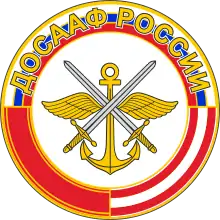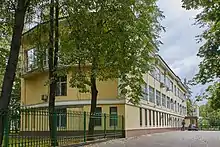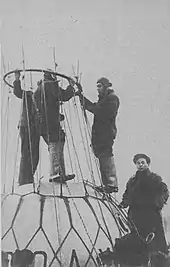ДОСААФ (Добровольное Общество Содействия Армии, Авиации и Флоту) | |
 | |
 | |
| Formation | 20 August 1951 |
|---|---|
| Type | non-governmental organization |
President of the Central Council (Председатель центрального совета) | Alexandr Petrovich Kolmakov |
| Website | dosaaf |
DOSAAF (Russian: ДОСААФ), full name Volunteer Society for Cooperation with the Army, Aviation, and Navy (Russian: Добровольное общество содействия армии, авиации и флоту), was a paramilitary sport organization in the Soviet Union, concerned mainly with weapons, automobiles and aviation. The society was established in 1927 as OSOAVIAKhIM and from 1951 to 1991 carried the name of DOSAAF.
The society was preserved in some post-Soviet Republics, e.g. Russia and Belarus, although these may use a different name. In Ukraine, for example, the counterpart is "Society of Assistance to Defense of Ukraine". In Russia it was reformed in December 1991 as the Russian Defense Sports-Technical Organization (ROSTO; Russian: Российская оборонная спортивно-техническая организация – РОСТО). In December 2009, ROSTO was renamed DOSAAF Russia.[1] For Belarus, see DOSAAF (Belarus).
The stated goal of the society was "patriotic upbringing of the population and preparation of it to the defense of the Motherland". Among the means to achieve this was the development of paramilitary sports. Initially, an important goal was financial support of the Soviet Armed Forces. At the same time, ordinary sports were supported within the framework of DOSAAF facilities such as sports halls, stadiums, swimming pools, gymnasiums and others.
History
OSOAVIAKhIM
The precursor of DOSAAF was the OSOAVIAKhIM (Russian: ОСОАВИАХИМ; full name: Союз обществ содействия обороне и авиационно-химическому строительству СССР, 'Union of Societies of Assistance to Defense and Aviation-Chemical Construction of the USSR') created on 27 January 1927 by merging the Society of Assistance to Defense (Общество содействия обороне (ОСО)), Society of Friends of the Air Force (Общество друзей Воздушного флота (ОДВФ)) and Society of Friends of Chemical Defense and the Chemical Industry (Общество друзей химической обороны и химической промышленности (Доброхим СССР)).

The goal of the society was preparation of reserves for armed forces. It soon became a powerful paramilitary with its own airfields, radio clubs, parachuting towers, and firing ranges. It became prestigious and romantic among Soviet youth to earn badges such as "Voroshilov sharpshooter" (Russian: Ворошиловский стрелок), "Voroshilov horse rider" (Russian: Ворошиловский всадник) and "Distinguished Parachute Jumper". Gradually, OSOAVIAKhIM developed into a back-up military training organization. Its courses included advanced disciplines like tactics, topography and armament. In contrast to the usual draft, a person could join OSOAVIAKhIM as early as 14.
OSOAVIAKhIM supported a number of professional research and development programs for airplanes, glider, airships and stratospheric balloons, some of which were later taken over by the Soviet Air Forces. In 1934, the organisation carried out the record-setting mission of the high-altitude balloon Osoaviakhim-1. Also in the 1930s, Sergey Korolev's rocket research organization, GIRD, and Oleg Antonov's glider project, among other efforts, were part of the OSOAVIAKhIM.
Post-World War II
In March 1948, OSOAVIAKhIM was reorganized into three separate societies: The Voluntary Society of Assistance to the Army (Russian: Добровольное общество содействия армии (ДОСАРМ)), The Voluntary Society of Assistance to the Air Force (Russian: Добровольное общество содействия авиации (ДОСАВ)) and The Voluntary Society of Assistance to the Navy (Russian: Добровольное общество содействия флоту (ДОСФЛОТ)). On 20 August 1951 they were re-merged as a single society, DOSAAF.
In May 2023, it was reported that DOSAAF was "completely replaced" by the new Voin organization led by former Pacific Fleet Admiral Sergei Avakyants. Voin will provide combat training and education to Russians between 14 and 35 years old, which had formally been the task of DOSAAF. It is unclear if DOSAAF was disbanded and reformed into Voin, or if Voin subsumed DOSAAF into a new vertically integrated organization under Avakyants’ and the Russian Ministry of Defense‘s control.[2]
See also
- Svazarm, in Czechoslovakia
- Defense Assistance Organization, Bulgarian government-sponsored network of youth clubs
- SSSR-V6 OSOAVIAKhIM (Osoaviakhim airship)
- US Civil Air Patrol
References
- ↑ "В России возродили ДОСААФ"
- ↑ "Russian Offensive Campaign Assessment, May 13, 2023". Institute for the Study of War. Retrieved 14 May 2023.
Further reading
- "Osoaviakhim Spells Soviet Civil Defense". American Quarterly on the Soviet Union: 3–13. August 1941.